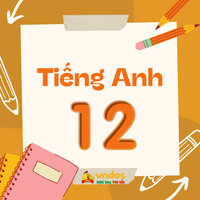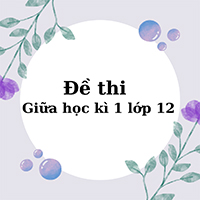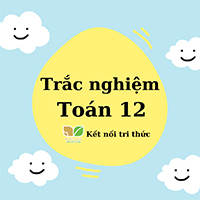Tiếng Anh 12 Review 1 Skills Global Success
Tiếng Anh 12 Review 1 Skills trang 46 Global success
Nằm trong bộ tài liệu Giải tiếng Anh 12 Kết nối tri thức theo từng Unit, Soạn tiếng Anh 12 Review 1 Skills giúp các em chuẩn bị bài tập SGK tiếng Anh hiệu quả.
Listening
1. Listen to a talk about three traditional festivals and their environmental impact. Number the pictures of the festivals in the order you hear.
(Nghe một bài nói chuyện về ba lễ hội truyền thống và tác động của chúng tới môi trường. Đánh số các hình ảnh về lễ hội theo thứ tự bạn nghe được.)
Bài nghe
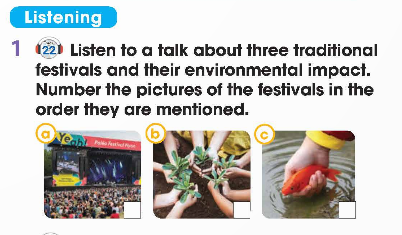
Gợi ý đáp án
|
a. 3 |
b. 1 |
c. 2 |
Nội dung bài nghe
Nowadays, both traditional and modern festivals are trying to reduce their carbon footprints and promote eco-friendly practices. Today, I'm going to talk about three of them.
Now, let's look at this photo. Well, this is Forest Festival or Van Mahotsav in India, a tree-planting festival taking place in the first week of July every year since 1950. Its aim is to raise people's awareness about the importance of forests in India. As part of the festival, thousands of trees are planted by both children and adults all over the country.
Next, I'll talk about Tet Festival, or Vietnamese New Year traditions. As part of the celebration, people release live fish into rivers a week before the festival officially begins. This tradition comes from an ancient story and is believed to bring good luck. It is also used to promote the protection and conservation of freshwater habitats. The event is now monitored by local authorities to ensure fish species are suitable for the ecological conditions of rivers.
Music festivals are also becoming eco-friendly, and one example is Paléo Festival in Switzerland, which is held in July every year. Back in 2009, it introduced reusable cups. Festival goers are also encouraged to use public transport as much as possible. Most food stalls sell local, organic, or vegetarian food. The festival is also committed to using 100 per cent green energy.
Now, do you know any other eco-friendly festivals or traditions?
2. Listen again and decide whether the following sentences are true (T) or false (F).
(Nghe lại và quyết định xem những câu sau đây đúng (T) hay sai (F).)
Bài nghe
1. People in India celebrate the Forest Festival (Van Mahotsav) annually.
2. Only adults can plant trees during the Forest Festival.
3. Vietnamese people release live fish into lakes and rivers after Tet Festival.
4. People who want to attend Paléo Festival shouldn't use their own cars to get there.
5. Food stalls at Paléo Festival are not allowed to use reusable cups.
Gợi ý đáp án
|
1. T |
2. F |
3. F |
4. T |
5. F |
Speaking
1. Work in pairs. Discuss the purpose and eco-friendliness of these festivals and traditions and complete the table below.
(Làm việc theo cặp. Thảo luận về mục đích và tính thân thiện với môi trường của những lễ hội và truyền thống này và hoàn thành bảng dưới đây.)
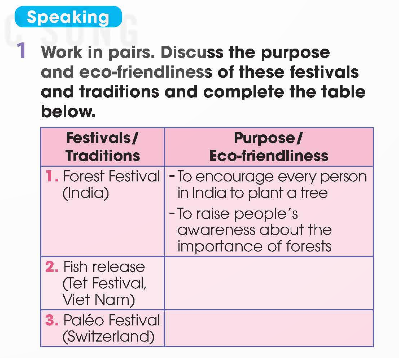
Gợi ý đáp án
|
Festivals/ Traditions |
Purpose/ Eco - friendliness |
|
1. Forest Festival (India) |
- To encourage every person in India to plant a tree - To raise people's awareness about the importance of forests |
|
2. Fish release (Tet Festival, Viet Nam) |
- To express environmental consciousness by fostering a connection between humans and nature - To promote the well-being of aquatic ecosystems |
|
3. Paléo Festival (Switzerland) |
- To celebrate cultural diversity through music, art, and performance - Has implemented initiatives to minimize its environmental impact, such as promoting public transportation and encouraging the use of reusable containers |
2. Work in groups. Choose a tradition or festival in your area. Discuss ideas about how to make this tradition or festival greener.
(Làm việc theo nhóm. Chọn một truyền thống hoặc lễ hội trong khu vực của bạn. Thảo luận các ý tưởng về cách làm cho truyền thống hoặc lễ hội này trở nên xanh hơn.)
Gợi ý đáp án
- Tet in Viet Nam (Tết ở Việt Nam)
+ Encourage the use of eco-friendly materials for traditional decorations such as bamboo, recycled paper, and natural fibers.
+ Organize clean-up activities before and after Tet to ensure public spaces remain litter-free.
+ Limit the use of plastic decorations and opt for reusable items that can be stored and reused.
Reading
1. Read the text about Alexandre Yersin. Mark the letter A, B, C, or D to indicate the correct answer to each of the following questions.
(Đọc đoạn văn về Alexandre Yersin. Đánh dấu chữ cái A, B, C hoặc D để chỉ ra câu trả lời đúng cho mỗi câu hỏi sau.)
Alexandre Yersin was born in 1863 in Switzerland, and passed away at the age of 80 in Nha Trang, Viet Nam. His family was originally from France. He was a doctor who made great contributions to medicine as well as the people in Viet Nam.
In 1890, Yersin left Europe to work as a medical doctor on a ship near Indochina, where he explored the region. In 1894, he was sent to Hong Kong to deal with an infected disease. Then, he discovered a bacterium responsible for the disease and saved millions of people's lives.
One year later, Yersin established a small laboratory in Nha Trang to prepare serums against the disease in human beings and cattle. To fund the laboratory, he started to grow corn, rice, and coffee, and introduced the rubber tree in Indochina. It later became a branch of the Pasteur Institute in Paris.
From 1902 to 1904, he lived in Ha Noi and helped establish Ha Noi Medical University. He was also the first medical director of the university. In 1920, he introduced the first effective drug for preventing and treating malaria in the region.
His house in Nha Trang is now the Yersin Museum. A university in Da Lat was named Yersin University in his honour.
1. Which of the following can be the best title for the text?
A. The story of a remarkable life
B. Yersin's research and exploration in Indochina
C. Yersin's contributions to medicine in Viet Nam
D. Yersin's childhood in Viet Nam
2. The word 'fund' in paragraph 3 is closest in meaning to _____.
A. introduce
B. grow
C. discover
D. finance
3. The word 'It' in paragraph 3 refers to _____.
A. cattle
B. laboratory
C. coffee
D. rubber tree
4. According to the text, which of the following information is true about Yersin?
A. He started living in Ha Noi in 1890.
B. He opened a university by himself.
C. He could find an effective method for treating malaria.
D. He had a house in Nha Trang, which was turned into a pharmacy.
Gợi ý đáp án
|
1. A |
2. D |
3. B |
4. C |
2. Read the following passage about Ton That Tung's contributions to the medicine in Viet Nam. Mark the letter A, B, C, or D to indicate the correct word that best fits each blank.
(Đọc đoạn văn sau đây về những đóng góp của Tôn Thất Tùng cho nền y học Việt Nam. Đánh dấu chữ cái A, B, C hoặc D để chỉ ra từ đúng phù hợp nhất với mỗi chỗ trống.)
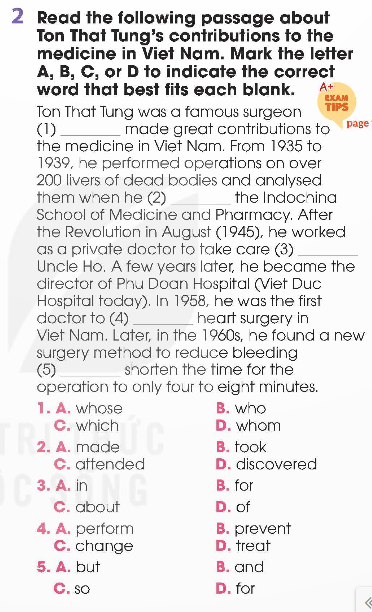
Gợi ý đáp án
|
1. B |
2. C |
3. D |
4. A |
5. B |
Writing
Use the information about Ton That Tung below and details from 2 in Reading above to write a biography (180 words) about Ton That Tung.
(Sử dụng những thông tin về Tôn Thất Tùng bên dưới và chi tiết ở phần 2 trong Bài đọc trên để viết tiểu sử (180 từ) về Tôn Thất Tùng.)
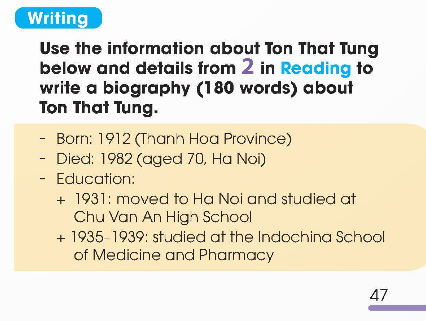
Gợi ý đáp án
Ton That Tung, born in 1912 in Thanh Hoa Province, Vietnam, was a renowned surgeon in the field of medicine. His educational journey began in 1931 when he moved to Hanoi and studied at Chu Van An High School. However, it was from 1935 to 1939 that he truly honed his medical skills, attending the Indochina School of Medicine and Pharmacy. During this period, he performed operations on over 200 livers of dead bodies and analysed them. After the Revolution in August 1945, he served as a private doctor, dedicated to the care of Uncle Ho. His passion for healing and thoroughness in healthcare leadership propelled him to the position of director at Phu Doan Hospital, known today as Viet Duc Hospital.
In 1958, Ton That Tung became the first doctor to successfully perform heart surgery in Vietnam. Later, in 1960s, he found a new surgery method to reduce bleeding and shorten operation times to a remarkable four to eight minutes. He passed away in Hanoi in 1982 at the age of 70 but his contributions to inspire and shape the medical landscape in Vietnam remain to this day.
Xem thêm nhiều bài viết tại: Write a biography (180 words) about Ton That Tung
Trên đây là Soạn tiếng Anh 12 Global Success Review 1 Skills đầy đủ nhất.



